Understanding Camera Optics & Smartphone Camera Trends, A Presentation by Brian Klug
by Brian Klug on February 22, 2013 5:04 PM EST- Posted in
- Smartphones
- camera
- Android
- Mobile
The Imaging Chain
Since we’re talking about a smartphone we must understand the imaging chain, and thus block diagram, and how the blocks work together. There’s a multiplicative effect on quality as we move through the system from left to right. Good execution on the optical system can easily be mitigated away by poor execution on the ISP for example. I put arrows going left to right from some blocks since there’s a closed loop between ISP and the rest of the system.
The video block diagram is much the same, but includes an encoder in the chain as well.
Smartphone Cameras: The Constraints
The constraints for a smartphone camera are pretty unique, and I want to emphasize just how much of a difficult problem this is for OEMs. Industrial design and size constraints are pretty much the number one concern — everyone wants a thin device with no camera bump or protrusion, which often leaves the camera module the thickest part of the device. There’s no getting around physics here unfortunately. There’s also the matter of cost, since in a smartphone the camera is just one of a number of other functions. Material constraints due to the first bullet point and manufacturing (plastic injection molded aspherical shapes) also makes smartphone optics unique. All of this then has to image onto tiny pixels.
Starting with the first set of constraints are material choices. Almost all smartphone camera modules (excluding some exceptions from Nokia) the vast majority of camera optics that go into a tiny module are plastic. Generally there are around 2 to 5 elements in the system, and you’ll see a P afterwards for plastic. There aren’t too many optical plastics around to chose from either, but luckily enough one can form a doublet with PMMA as something of a crown (low dispersion) and Polystyrene as a flint (high dispersion) to cancel chromatic aberration. You almost always see some doublet get formed in these systems. Other features of a smartphone are obvious but worth stating, they almost always are fixed focal length, fixed aperture, with no shutter, sometimes with an ND filter (neutral density) and generally not very low F-number. In addition to keep modules thin, focal length is usually very short, which results in wide angle images with lots of distortion. Ideally I think most users want something between 35 mm or 50 mm in 35mm equivalent numbers.
I give an example lens catalog from a manufacturer, you can order these systems premade and designed to a particular sensor. We can see the different metrics of interest, thickness, chief ray angle, field of view, image circle, thickness, and so on.
During undergrad a typical homework problem for optical design class would include a patent lens, and then verification of claims about performance. Say what you want about the patent system, but it’s great for getting an idea about what’s out there. I picked a system at random which looks like a front facing smartphone camera system, with wide field of view, F/2.0, and four very aspherical elements.
Inside a patent is a prescription for each surface, and the specification here is like almost all others in format. The radius of curvature for each surface, distance between surfaces, index, abbe number (dispersion), and conic constant are supplied. We can see again lots of very aspherical surfaces. Also there’s a doublet right for the first and second element (difference in dispersion and positive followed by negative lens) to correct some chromatic aberrations.
What do these elements look like? Well LG had a nice breakdown of the 5P system used in its Optimus G, and you can see just what the lenses in the system look like.


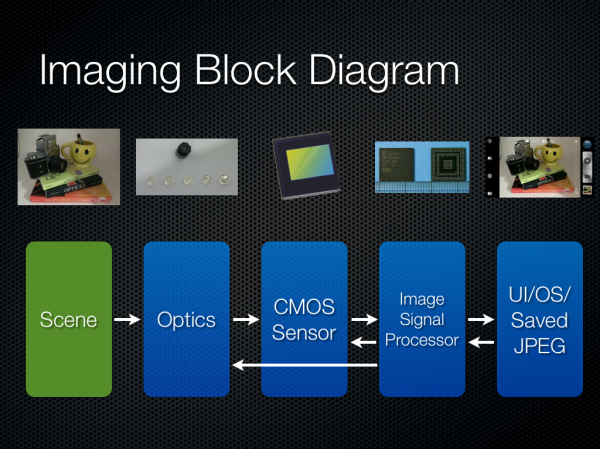
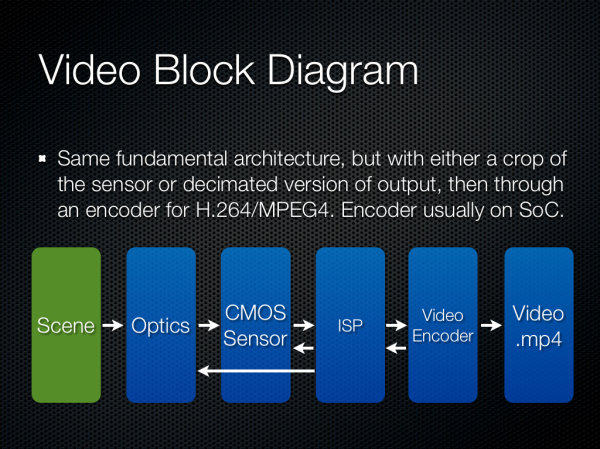
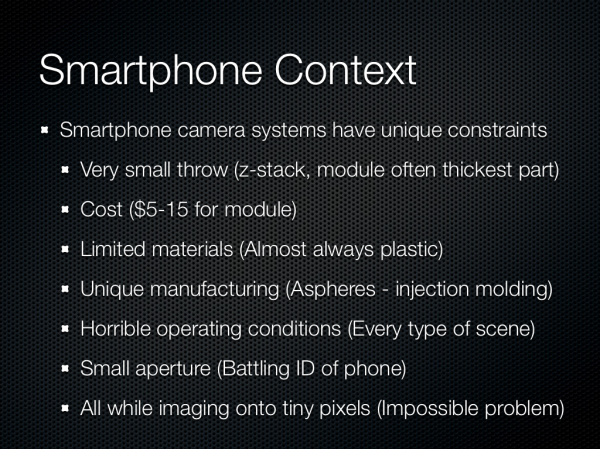
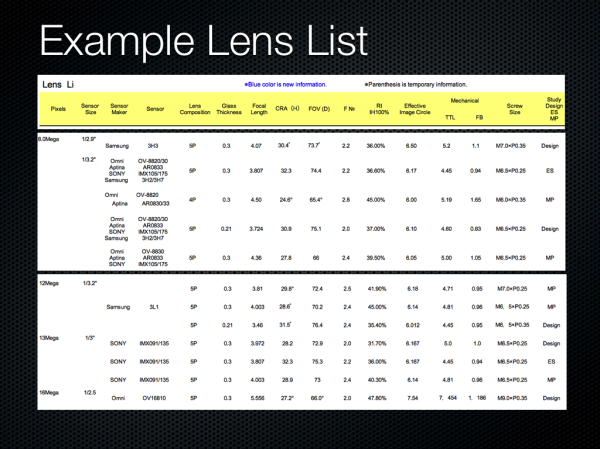
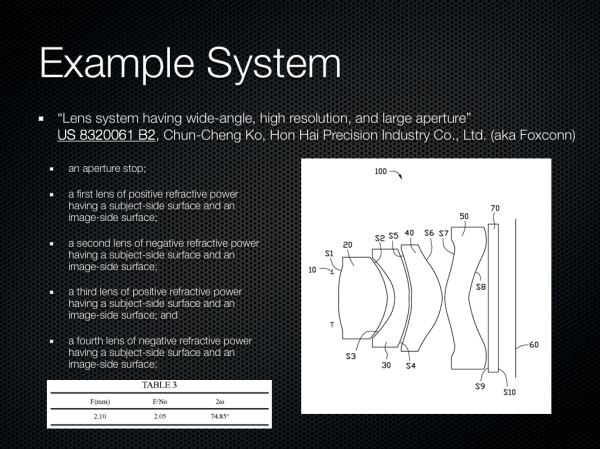
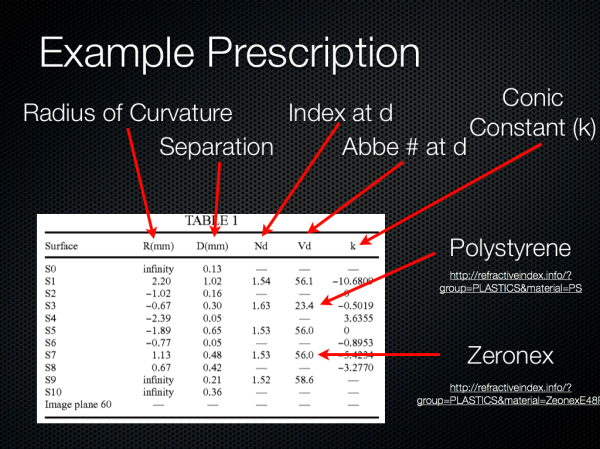
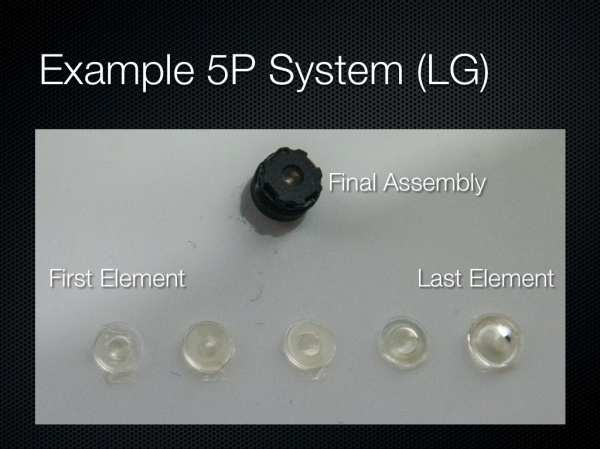








60 Comments
View All Comments
gadjade - Friday, February 22, 2013 - link
How can I start reading when there is no mention of any Nokia products? HTC One should not be even included in the article because it's not even considered a breakthrough in camera phones.Krysto - Saturday, February 23, 2013 - link
Next time try reading more than the first paragraph.Diagrafeas - Saturday, February 23, 2013 - link
How many MP or to be more accurate Million Sub Pixels are these Nokia sensors because these numbers come surely after interpolation or pixel shift or something...Also do we have information about HTC One sensor?
Is it one Bayer sensor or 2-3 stacked like Foveon ones?
Krysto - Saturday, February 23, 2013 - link
While HTC definitely deserves credit for discontinuing a trend of ever more MPs, I don't think they went far enough. There's still an unclenched status quo thinking in smartphones about sensor size. Virtually all of them have a 1/3.2" sensor.No one has even thought about making that one much larger? Even after Nokia showed Pureview 808 and got a lot of praise for it? Really? What is wrong with all these companies? Do they want us to spell it out for them?
I get that clean phone design is a big factor, but you can't just keep doing things the same way everyone has always done it. And then they wonder why they can't beat Samsung. Sure Samsung has a lot of marketing power, but they also play a little less safe than everyone else. They add the S-pen to devices, even though it adds quite a bit of cost and then they need that device to compete with others, so it's a risk for them that the consumers might not want to pay extra for it - but they still do it. They also started the "phablet" trend all by themselves. And while these things don't necessarily have mass market appeal, they get a lot of publicity and quite a lot of passionate fans and customers for those devices.
So why aren't the other manufacturers experimenting in the same way not just with incrementally better cameras, but WAY better cameras, that they put in phones. I'm talking putting camera capabilities in a phone that could add $100 or even $200 to the retail price of the device. That's being BOLD in the market. That's being DIFFERENT.
So I want to see them come up with devices that have 1" large sensors of 5-8 MP, with some high quality lenses, and powerful ISP's and software behind them. Create that and you get at least 3 different types of consumers coming to buy that phone (the type of consumers that yell :SHUT UP AND TAKE MY MONEY!): professional photographers (they buy thousands of dollars worth of equipment for fun, and they need phones, too), amateur photographers (people who love taking great photos with their phones), and you'd also pretty much convert the whole (in time of course) point and shoot market to your device.
So the potential for sales is right there for reaping. And these people wouldn't get about a slight bump on the back, if they can get a phone that is 5x better than anything else on the market at the time of shipping. I want to see that kind of LEAP in smartphone cameras, not just these regular "2013 camera is slightly better than the 2012 camera", and so on.
slatanek - Saturday, February 23, 2013 - link
I think you're generally right, but these days from manufacturer's point of view it's very easy to sink the ship by being bold and not being understood well by the market/consumers. It is then very easy for their opponents to do nasty counter marketing to make things worse even further.As a photographer myself I really would like to see a no compromise smartphone camera (give glass!!! give me bigger sensor with less megapixels!!!), but I guess we're not at that point just yet. Only recently manufacturers of compact cameras started to show some interest for making cameras geared toward serious photography, so I guess it's still a few years wait to see that approach in the smartphone world.
slatanek - Saturday, February 23, 2013 - link
Besides I guess 1" sensor in a smartphone will never happen due to physical constrains - you need a lot of light gathering power to lit such a huge sensor not to mention the focal distance needs to be considerably bigger for the field of view not to be ultra wideKrysto - Saturday, February 23, 2013 - link
Pureview 808 had a 1/1.2" which is pretty close, and didn't look too bad:http://images.fonearena.com/blog/wp-content/upload...
Tarwin - Saturday, February 23, 2013 - link
That's kinda the point. It didn't look TOO BAD, which is a far cry from looking great. I also remember reading some reviews which complained about the ergonomics. Also the pure view was more of a niche experimental product.It's kind of like some article that I read years agonwhere itnsaidnthat according to research (or a survey or something) consumers, when buying a tv), were most interested in size THEN image quality and then all the other stuff. Most phone buyers are similar, they want a better camera but are not willing to give up styling for it, at least not without some re-education.
As for HTC not going far enough. I think it has more to do with the fact that they're not doing too well as is and most likely feel like they're taking enough risks at the moment.
Personally I would be willing to give up some slimness (but hopefully not styling) for a decidedly improved camera. I hope HTC does well with the One and that they are willing to experiment a bit more in future generations. But then again I am not sure yet how I feel about the loss in detail. Another site got their hands on a One and have some comparison shots between the On eand the iPhone 5
Tarwin - Saturday, February 23, 2013 - link
Oops, accidentally pressed post.Well, in the comparison shots I prefernthe images ofnthe One, but I occasionally neednthe detail procided with 8MP but then again only sometimes. When 4K TVs vecome mainstream and I also have one then I'll kost likely think it's the minimum pics should be taken at.
Krysto - Monday, February 25, 2013 - link
They can make it more stylish than that. I wouldn't mind if my phone looked a bit like a point and shoot, and didn't have a perfectly flat back surface.Again, I'm not saying these phones are for everyone. Note phones are not for everyone either. In fact I don't think I can ever see myself owning a Note phone. But yet millions of people have them, and those who do love it, and wouldn't imagine going back to a smaller phone.
That's the type of market I think such a phone can target. A niche market indeed, but a big niche nonetheless. And I would be part of that niche.